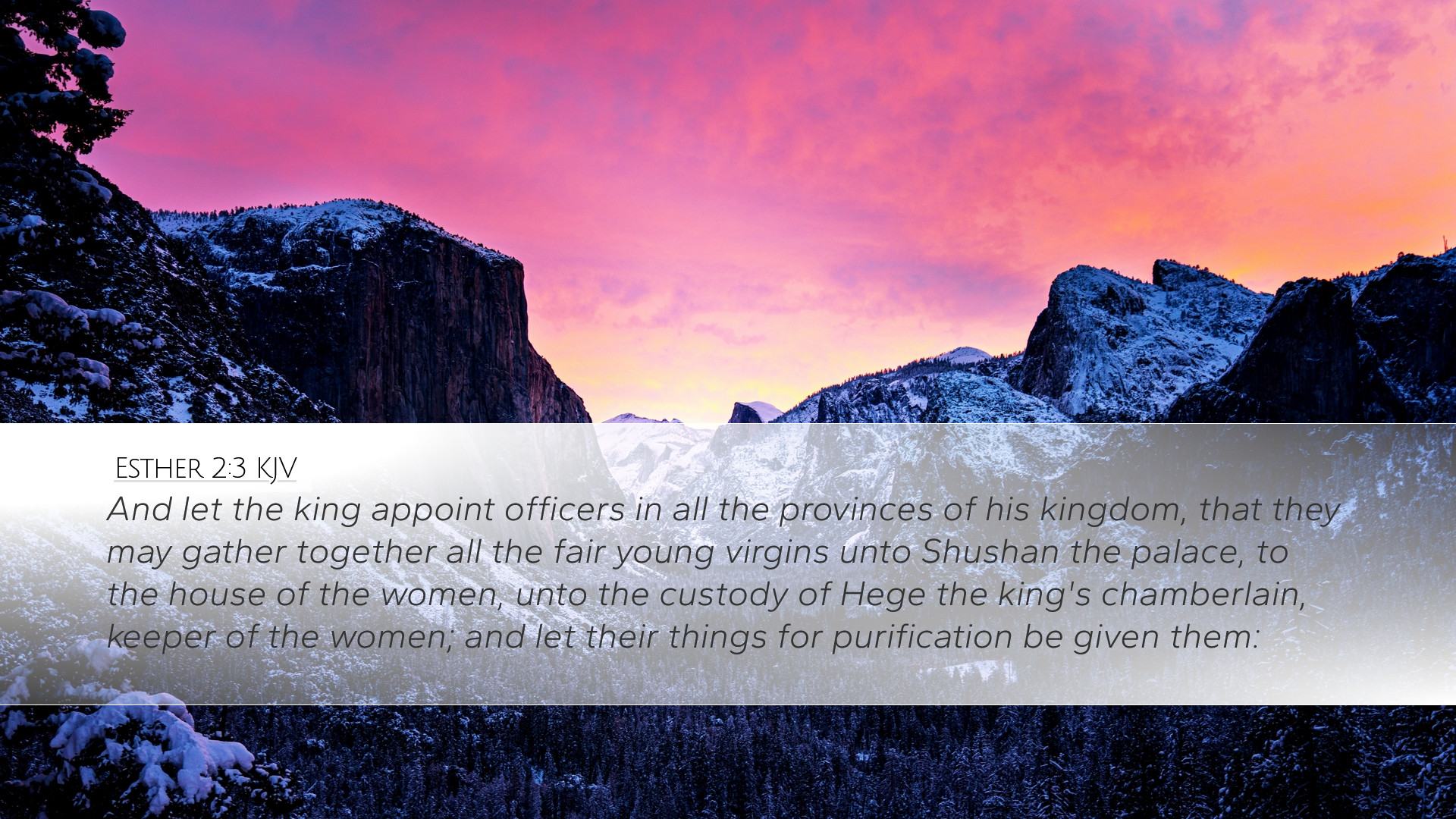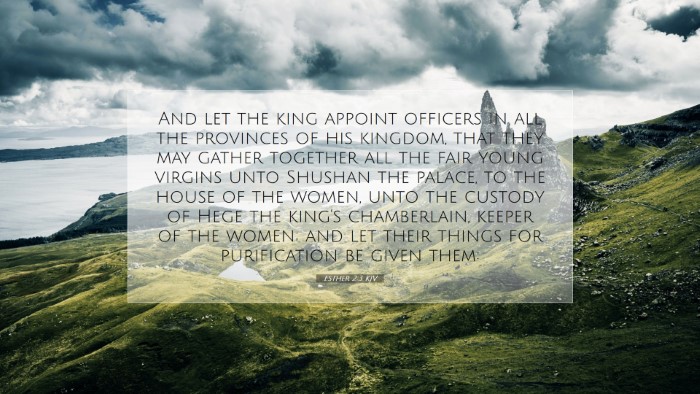Old Testament
Genesis Exodus Leviticus Numbers Deuteronomy Joshua Judges Ruth 1 Samuel 2 Samuel 1 Kings 2 Kings 1 Chronicles 2 Chronicles Ezra Nehemiah Esther Job Psalms Proverbs Ecclesiastes Song of Solomon Isaiah Jeremiah Lamentations Ezekiel Daniel Hosea Joel Amos Obadiah Jonah Micah Nahum Habakkuk Zephaniah Haggai Zechariah MalachiEsther 2:3
Esther 2:3 KJV
And let the king appoint officers in all the provinces of his kingdom, that they may gather together all the fair young virgins unto Shushan the palace, to the house of the women, unto the custody of Hege the king's chamberlain, keeper of the women; and let their things for purification be given them:
Esther 2:3 Bible Commentary
Bible Commentary on Esther 2:3
Verse Context: Esther 2:3 states: "And let the king appoint officers in all the provinces of his kingdom, that they may gather together all the fair young virgins unto Shushan the palace, to the house of the women, unto the custody of Hege, the king's chamberlain, keeper of the women; and let their things for purification be given them."
Introduction
Esther 2:3 marks a significant step in the narrative of the Book of Esther. This verse aligns with the broader themes of God's providence, the sovereignty of the king, and the role of women in ancient society. Commentaries from esteemed theologians such as Matthew Henry, Albert Barnes, and Adam Clarke provide profound insights into the implications of this passage. This commentary unpacks the verse in context, exploring its theological significance and practical applications.
Verse Analysis
1. The King's Decree
Matthew Henry's Insight: Henry observes that the king's decree reflects the authority and power wielded by kings in the ancient Near East. This kind of command indicates that the king, Ahasuerus, possessed the right to summon young women as he pleased, reflecting the volatile and sometimes harsh nature of his authority.
Albert Barnes Commentary: Barnes notes that the king's decision was not only about selecting a queen but also about establishing a certain level of control over his dominion by consolidating his power. This appointment demonstrates the king's need for loyalty and submission, which was paramount in a monarchy.
2. Gathering of Young Virgins
The gathering of young virgins into the palace shows the societal values of the time, where beauty and chastity were highly prized. The process of selection represented the cultural norms surrounding marriage, power, and female virtue.
Adam Clarke's Perspective: Clarke emphasizes the institution of beauty selection as a common practice in royal courts. He notes that this procedure effectively played a role in not just the personal desires of the king but also in the socio-political dynamics of Persian society. The focus on "fair young virgins" highlights the objectification and commodification of women in this context.
3. The Role of Hege
Matthew Henry: The appointment of Hege as the keeper of the women indicates a structured, albeit patriarchal, oversight of the women who were to be gathered. This role is critical in the process, showcasing a hierarchical social structure and the role of guardianship.
Barnes' Commentary: Barnes explains that Hege's role reflects the significance of the women's preparation before they could appear before the king. This process involved physical beauty rituals, denoting the lengths to which individuals would go to be accepted in royal favor.
Theological Themes
1. Divine Providence
Although the characters in Esther’s story often act out of human motives, God's providential hand orchestrates the events leading to Esther's rise as queen. This theme underscores the belief that God is in control even when it appears that circumstances are chaotic.
2. The Sovereignty of God
Esther’s eventual rise to a position of influence demonstrates that worldly powers (like a king's choice) cannot thwart God's ultimate purposes. This narrative serves as reassurance that God can work through secular authorities to fulfill divine plans.
3. The Importance of Women in God's Plan
The selection of Esther as queen highlights the significant roles women can play in God's narrative of redemption and deliverance. The commentary stresses that, although Esther’s situation initially appears as a mere act of beauty contest, God uses her to accomplish greater plans for His people.
Practical Applications
- Understanding Authority: The nature of Ahasuerus' power serves as a reminder of the challenges that come with authority. Pastors and leaders must recognize their responsibility and the moral implications of their decisions.
- God’s Sovereignty in WE: Believers can rest in the assurance that, no matter the human decisions being made around them, God's plans will ultimately prevail. This encourages Christians to trust God's unfolding narrative in their lives.
- The Value of Women: The role of beauty and virtue in this passage invites a deeper examination of how society views women. The Church is called to uplift and empower women, recognizing their vital contributions to God’s mission.
Conclusion
Esther 2:3 serves as a critical pivot point in the unfolding of the Esther narrative, where significant themes such as authority, beauty, and divine providence converge. The insights gleaned from revered public domain commentaries enrich our understanding and application of this verse. As students and theologians delve into these texts, they are encouraged to see beyond societal norms of the day and recognize God’s hand at work, guiding history towards His ultimate purposes.


